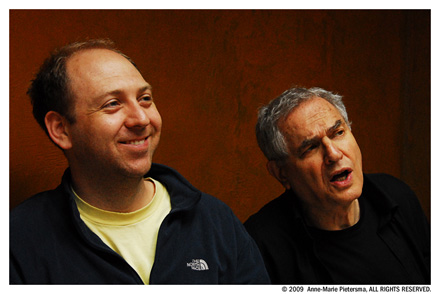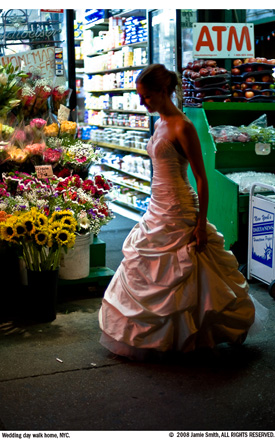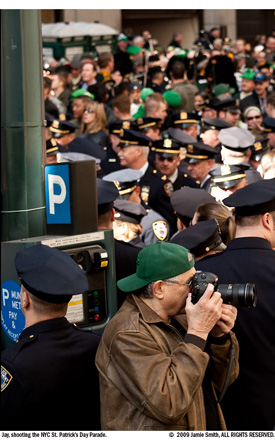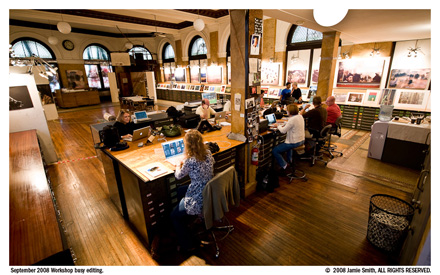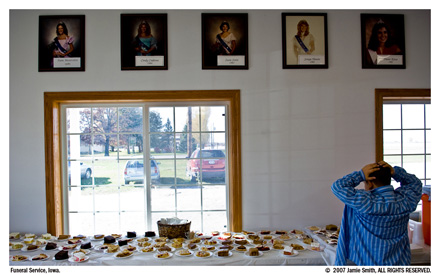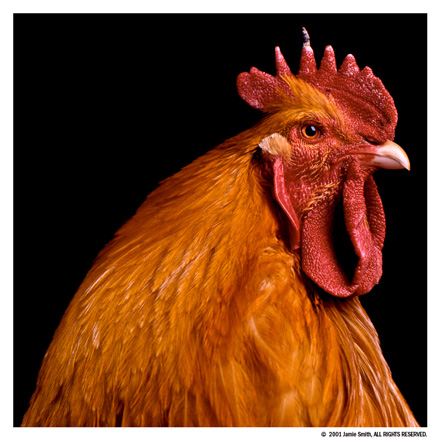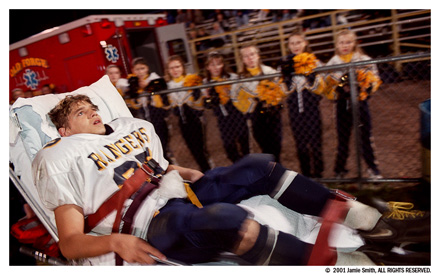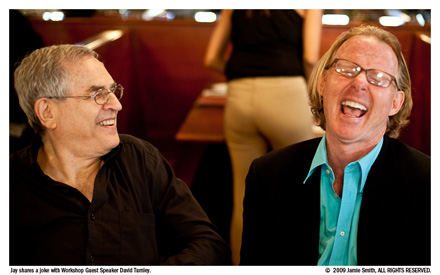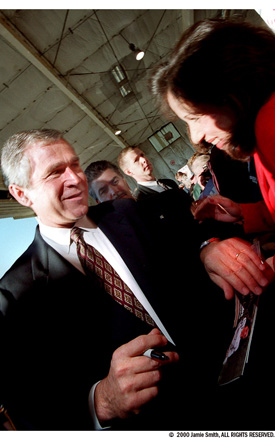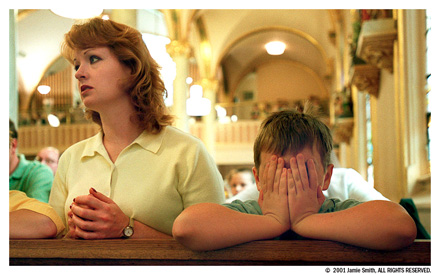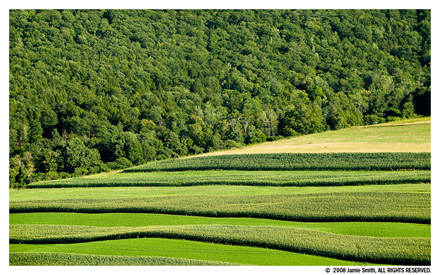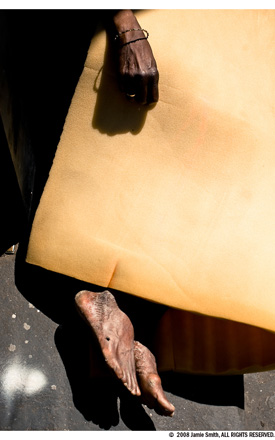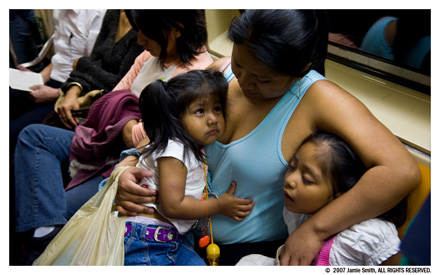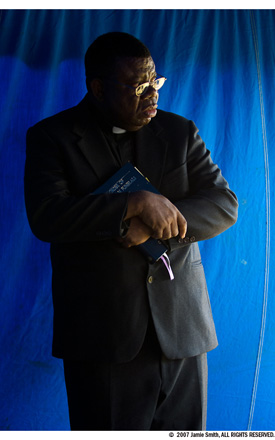WHAT IS LIFE LIKE AS AN ASSISTANT?
There is no perfect existence, but being blessed with a beautiful wife and working for Jay Maisel is pretty close – for starters my cubicle is more than TEN times the size of our entire NYC apartment. At home we “share” the closet, at work I share space with a basketball hoop. I got engaged at the bank building and we were married there. (Yes, I’m currently in negotiations about a cemetery plot in the courtyard.)
THEY ASKED ME TO DESCRIBE WORKING FOR JAY?
There is no job description. The closest answer I ever got was: “everything.” For those of you who speak Jay’s language that is easily translated: “every f#%@ing thing.” It seems contradictory to say that his answer was both concise and vague – but it is accurate since assisting boils down to one simple task: make your employer’s life easier.
There is no typical day, week, or month – Jay is just an average 78-year-old world-class photographer/artist who shoots every day and owns a 110-year-old landmark building in Manhattan. To him the word retirement will never exist and I do my best to keep up with his level of energy and creative passion. Besides keeping things organized around the building and the normal administrative duties, I’m in charge of downloading cards, processing as well as archiving files, and printing. Although he’s told me he was initially hesitant about digital, he has not shot a single frame of film in ten years. His career however has spanned five plus decades (and counting) – meaning he has over a million chromes that need to be scanned.
Third on my list, Jay still enjoys traveling and lecturing. Throughout his career he has taught over a hundred workshops in various places all over the country. In 2007 he decided to create his own unique week-long workshop at his building in New York City. If you’ve seen his former students’ comments you know he gets high marks as a teacher. As his assistant, each of those weeks involves coordinating lots of logistics and long hours, but helping with the workshop is one of the most rewarding aspects of the job. I have the privilege of listening to remarkable guest speakers like Gregory Heisler and develop lasting friendships with the participants who come from all over the world to learn from Jay. Oh, and I’m paid to be part of that? When does the extra set of free steak knives arrive?
ROAD MAP TO BECOMING AN ASSISTANT: A little background about me.
I grew up in Palo Alto, California and developed a work ethic in third grade when I started working for a neighborhood friend/mentor. At The University of California, Santa Barbara I had a great photography professor named Richard Ross who stressed the importance of lighting, access, and content. Digital photography hadn’t really taken off at that time so all of my formal training was with film, and it wasn’t really all that formal. Like everyone else, I later faced growing pains while educating myself about digital – an ongoing process that is obviously vital to being a good assistant, but ultimately dull compared to what first interested me about photography.
Post college was the basic catch 22 – with no experience I wanted to find a job as a photographer, but “Hire me, I have no idea what I’m doing” proved to be a tough sell. I started at the bottom, spending a year doing all the cliché grunt work as an assistant at a commercial studio. That ended abruptly when they refused to discuss any compensation for stock images I shot that they were licensing to an agency. Getting burned like that was a learning experience and like chicken pocks, I recommend getting it over with early in one’s career – it’s less severe, and less likely that you’ll let it happen again.
Starting to shoot on my own, I spent about five years taking freelance newspaper assignments in Pennsylvania and California. I can remember the first meeting I had with a photography editor at the San Diego Union-Tribune. I showed him some pictures; he asked if I had a digital camera, I said no, he told me to call back if I ever got one. I made the switch. Because of that encounter, digital for me wasn’t initially about the excitement of new technology (I had no idea what a color space was), or the result of a carefully calculated business plan (a digital camera body cost the same as three film lenses, a film body plus a flash!). The decision was about whether I wanted work as a photographer or not… Journalism was a great way to get paid to shoot, have work published, learn to meet deadlines, plus I had a long leash and got exposure to a variety of subjects and environments. I also learned a second major lesson: WORK FOR HIRE. (If you don’t know what that means do some research immediately!)
THEY ASKED ME TO WRITE ABOUT: How I met Jay?
I don’t think I’ve ever had a job interview in my life, so I guess I met him serendipitously. While living in San Diego I became involved with the local chapter of the American Society of Media Photographers, eventually serving on the board as secretary. In other words, I was the youngest person elected and an easy target to be nominated head note taker. In all seriousness though, I learned a great deal about copyright and other photography business practices as a result of that affiliation. I went to most meetings and seminars in an effort absorb as much as possible – that included attending a photo convention where I first heard some guy dressed in a black T-Shirt and black 501 jeans with an unmistakable lisp dropping F-bombs every other sentence as he talked about his picture of the arrow in the Fed-Ex logo. (If you’ve seen him speak you understand, if not, keep looking it IS there).
The next MAJOR personal photography epiphany was taking Seth Resnick and Jamie Spritzer’s D-65 Workflow class. They are the best; whatever they charge it isn’t enough. A year later, Seth formally introduced me to Jay. One more year passed until we moved to NYC without any leads on apartments or jobs. I eventually got a few freelance assisting gigs with a great fashion/beauty shooter named Joseph Cartright. At some point Jay and I met up for lunch and he asked, “If you came to work for me, what can you offer me, and what would I offer you in return?” I didn’t have an answer and we squabbled about who would be picking up the check. It is fair to say we are both stubborn, but the argument resolved itself immediately when Jay realized he didn’t have his wallet. (He hasn’t let me pay for lunch since.) Weeks later I came to work for him on a part-time trial basis. I was so excited that it was two weeks before I bothered to inquire about a paycheck.
THEY ASKED ME IF I HAVE ANY ADVICE FOR ASPIRING ASSISTANTS?
Yikes! I’ll try… First and foremost consider if you truly want a career as an assistant, or if assisting is something you view as a stepping stone to becoming a photographer, a studio manager, an art director, or an editor, etc. I recommend finding someone whose work you admire – be sure you know something about the person and are able to discuss his or her work before you inquire about a job. Keep in mind that they don’t necessarily have to be great teacher and may not become your best friend. You can learn through osmosis and this is a job, not an unpaid internship – their primary motivation is not paying you to learn from them – otherwise you are just another liability.
I’m always amused when assistants gripe about having to do less desirable chores – expect to get your hands dirty. Other than that, be organized, calm, have a sense of humor, try to foresee any avoidable problems, be courteous, and act professional. Educate yourself as much as you can – there are lots of photographers with very accomplished careers who need help with computers, software, and printing. If you become reliable and trustworthy that is valuable to any employer. With the right personality fit you may benefit from their artistic sense as much as they benefit from your technical knowledge. And if all else fails remember what Woody Allen says, “90% of life is just showing up.”
If assisting is just a short term way to help you get to your ultimate goal (which it is for most people), I’d recommend being certain you are comfortable sacrificing time and energy dealing with someone else’s priorities – be focused on their projects when you are working for them (i.e. be on time, don’t be texting during a shoot). But being hypocritical for a second, schedule time for personal projects to have a creative outlet. Me, I shoot when possible and build stuff out of the junk I collect on the Bowery – the nice thing is Jay has a place to store it…
And when it’s getting time to move on, make sure to communicate it well in advance so that no one is caught off guard – any good photographer will understand that you need to think about your own career. As long as they have time to find a replacement they will continue to be supportive long after you are their employee.
I’m a huge fan of Bill Irwin and recently saw ‘Waiting For Godot.’ If you’re like me, and assisting is not the end game, you might also find it interesting to research this play and the master/slave relationship aspect in Lucky’s character…
JAY MAISEL TRIVIA: Things you might not have known about Jay…
$#x2022; His formal training was in painting, so luckily he has a fallback.
$#x2022; In 1963 he placed second in the North American Karate Championships at Madison Square Garden.
$#x2022; He worked and traveled with Buckminster Fuller building models and geodesic domes.
$#x2022; The first and second covers of New York Magazine where shot by Jay.
$#x2022; He did the “first” Sports Illustrated Swim Suit Issue cover in 1965. (16 SI covers total)
$#x2022; This year marks the 50th anniversary since his photo of Miles Davis was used as the cover on the ‘Kind of Blue’ album, the best selling jazz album in history.
$#x2022; At one point Roy Lichtenstein and Adolph Gottlieb each rented floors from Jay and worked out of the bank.
$#x2022; He got the bank building in 1966 – it took an entire year to clean it out – but like the rest of the Bowery or any great artist’s career, one could argue it will always be a work in progress.
$#x2022; Maisel is pronounced MAY-zell.
When I started to write this I thought, “what can I possibly say about Jay that he hasn’t already said about himself?” I hope I’ve added to the conversation. Thanks to Scott and the entire gang at NAPP for allowing me to be today’s guest. I’d love to see everyone at Photoshop World one of these days. I’ll have to check with my boss about getting time off, don’t believe all the puppy dogs and ice cream stuff you’ve heard – he’s a real jerk!
To Jay – until they invent a darker color that hides food stains better and doesn’t reflect in glass while you are photographing, keep rockin’ the black-on-black ensemble and thanks for “everything.”
Best,
Jamie Smith (Assistant)
LINKS:
$#x2022; Jay Maisel/Jay Maisel Workshop
$#x2022; Richard Ross
$#x2022; Seth Resnick & Jamie Spritzer/D-65
$#x2022; Joseph Cartright
$#x2022; David Turnley
$#x2022; Gregory Heisler
$#x2022; The one and only, Bill Irwin
$#x2022; ASMP
$#x2022; Photoshop World



